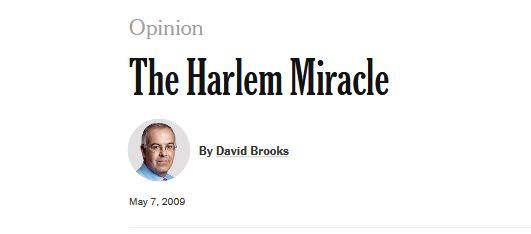
David Brooks on "The Harlem Miracle"
By Steve Sailer
05/10/2009
David Brooks writes in the New York Times:
The Harlem MiracleThe fight against poverty produces great programs but disappointing results. You go visit an inner-city school, job-training program or community youth center and you meet incredible people doing wonderful things. Then you look at the results from the serious evaluations and you find that these inspiring places are only producing incremental gains.
That’s why I was startled when I received an e-mail message from Roland Fryer, a meticulous Harvard economist. It included this sentence: “The attached study has changed my life as a scientist.”
Fryer and his colleague Will Dobbie have just finished a rigorous assessment of the charter schools operated by the Harlem Children’s Zone. They compared students in these schools to students in New York City as a whole and to comparable students who entered the lottery to get into the Harlem Children’s Zone schools, but weren’t selected.
They found that the Harlem Children’s Zone schools produced “enormous” gains. The typical student entered the charter middle school, Promise Academy, in sixth grade and scored in the 39th percentile among New York City students in math. By the eighth grade, the typical student in the school was in the 74th percentile. The typical student entered the school scoring in the 39th percentile in English Language Arts (verbal ability). By eighth grade, the typical student was in the 53rd percentile.
Forgive some academic jargon, but the most common education reform ideas — reducing class size, raising teacher pay, enrolling kids in Head Start — produce gains of about 0.1 or 0.2 or 0.3 standard deviations. If you study policy, those are the sorts of improvements you live with every day. Promise Academy produced gains of 1.3 and 1.4 standard deviations. That’s off the charts. In math, Promise Academy eliminated the achievement gap between its black students and the city average for white students.
Let me repeat that. It eliminated the black-white achievement gap. “The results changed my life as a researcher because I am no longer interested in marginal changes,” Fryer wrote in a subsequent e-mail. What Geoffrey Canada, Harlem Children’s Zone’s founder and president, has done is “the equivalent of curing cancer for these kids. It’s amazing. It should be celebrated. But it almost doesn’t matter if we stop there. We don’t have a way to replicate his cure, and we need one since so many of our kids are dying — literally and figuratively.”
These results are powerful evidence in a long-running debate.
Not really.
If you stop and think, you'll notice that this experiment says less than David Brooks implies it says about the "black-white achievement gap" because there’s no control group of white students in this study. Nobody bothered to check to see how much white students' scores would go up if a huge amount of money was given to a well-known superstar educator (in this case, Geoffrey Canada — here’s a more skeptical analysis of Canada’s accomplishment in Slate in 2008).
It’s not that hard to increase school achievement test scores. It’s especially not hard to do it in a handful of schools. (It’s hard to replicate a local success, though, just like it’s hard to take a cool movie, like "The Matrix," and make it a cool series, or to take a cool movie like "The Manchurian Candidate" and come up with a cool remake. Sometimes with movie-making, all the pieces click, other times not. Much the same is true for schools.)
What’s hard is to get rid of the racial gap.
More impressively, at great expense, the overall U.S. has improved math achievement test scores over the last quarter of a century or so, as measured by the federal NAEP test. Unfortunately, the "problem" is that white scores have gone up about as much as black and Hispanic scores have gone up. The No Child Left Behind act explicitly claims it is supposed to fix this "problem," which is how I got into this lengthy discussion among Saletan, McWhorter, Millman, and so forth.
Personally, I would describe the broad rise in math scores as less a "problem" than an "accomplishment," but mine is a minority view.
To solve The Problem, we could hit the white and Asian kids on the head with a ballpeen hammer, and that would keep the black and Hispanic kids from being left behind, but so far, we just haven’t been willing to do what it takes.
Speaking of Roland Fryer, here’s a fun article from 02381 called "A Million Little Writers" by Jacob Hale Russell on how many famous Harvard professors, such as longtime iSteve favorites Alan Dershowitz, Henry Louis Gates, and Roland Fryer, are more brand names and impresarios than they are the actual authors of the stuff churned out under their names. (And, getting completely off the topic, here’s a comment to my blog from Charles Johnson, the high school student employed by Dershowitz as a ghostwriter, defending Dershowitz’s use of a minor to write rough drafts for him.)
In 2005, when Dr. Fryer was promoting a theory that hypertension among blacks was caused by Darwinian selection on the Middle Passage, evolutionary theorist Greg Cochran offered to help him come up with a more mathematically realistic model of the evolution of African American hypertension, but Fryer refused all help from Cochran.
